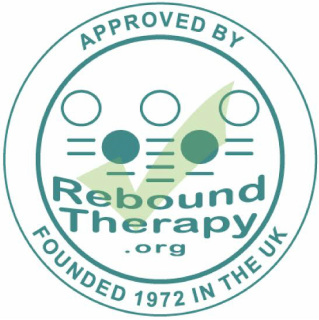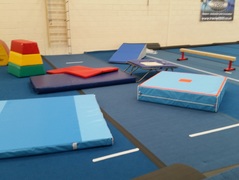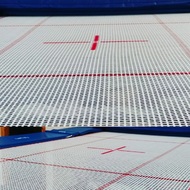
Rebound Therapy is now available in Ireland! From September 2014 Stuntworx Elite have been the first club in the country to offer a much needed service to Ireland and the local community. After a very successful pilot scheme working with local children on the autism spectrum, we have now opened our therapy to the public.
Eddy Anderson, the founder of Rebound Therapy, answers the question:
What is Rebound Therapy?
Summary: The phrase ‘Rebound Therapy’, when correctly applied, describes a specific methodology, assessment and programme of use of trampolines to provide opportunities for enhanced movement patterns, therapeutic positioning, exercise and recreation for a wide range of users with additional needs.
Students' progress is recorded using the Winstrada development programme. Grades 1 and 2 of this programme are based entirely on the genuine 'Eddy Anderson model' training course as detailed on this website.
When working with students with profound or complex needs, progress can be accurately measured and recorded using the Huddersfield Functional Index in conjunction with the.Winstrada development programme.
The phrase "Rebound Therapy" was coined by the founder, E.G. Anderson, in 1969 to describe the use of trampolines in providing therapeutic exercise and recreation for people with a wide range of special needs.
Participants range from mild to severe physical disabilities and from mild to profound and multiple learning disabilities, including dual sensory impairment and autistic spectrum.
Rebound Therapy is used to facilitate movement, promote balance, promote an increase or
decrease in muscle tone, promote relaxation, promote sensory integration, improve fitness and
exercise tolerance, and to improve communication skills.
The principles of Rebound Therapy form the basis of all gymnastic movement and are therefore a logical and advisable starting point for trampoline coach training – even for those who have no intention of teaching people with disabilities.
The official UK body and international consultancy for Rebound Therapy is Rebound Therapy.org. They are responsible for the provision of certificated and accredited training courses.
Most of us have paused when confronted by yet another piece of jargon, "Oh no-Here we go
again! What on earth is Rebound Therapy?" In one sense that is a slightly inaccurate question, for the true value of Rebound Therapy lies in the fact that part of what occurs is not "on earth". The essential value of the process is that, for a brief moment, ‘earth’ is left behind, and a new freedom is found in controlled movement away from gravity's straitjacket, in a sort of relaxed 'poetry of motion' available to all, irrespective of any disability.
The following statements have been culled from a large number of workshops in the U.K. over
the past twenty years. The work and its development continue, but the comments remain valid,
and, as I refer to them I would like to take the opportunity of expressing my grateful thanks to
colleagues, staff and students, parents and clients who have made such a valuable contribution to
the development and understanding of Rebound Therapy.
The unique properties of the trampoline offer ample opportunities for everybody to enhance
movement patterns.
The work is intrinsically motivating and returns high value in therapeutic terms for the time and
the effort involved. Benefit is enhanced considerably when the operator achieves the skill to
create variable patterns of movement in harmony with the needs of the user. The two then share
the surface of the trampoline with operator adjusting the effect of weight and speed in order to
ensure smooth transitions between the phases of movement undertaken.
That sums it up in essence, but let us examine the trampoline and its properties in more detail:
Physical Properties of the Trampoline
1) Unique, three-fold effect on body organs, systems and muscles
A) weight increases and decreases to the point of weightlessness
B) there is acceleration from stillness to varying speeds
C) there is deceleration from varying speeds to stillness
2) Storage of potential energy - as the trampoline bed is under tension with springs it is a
potential energy source
3) Output of energy - this varies according to the energy put in; the bed stores the input
energy unto output. As in Newton's 3rd Law of Motion. 'for every action there is an equal and
opposite reaction'.
4) Potential for lifting a body into space - as a result of item (2), the trampoline bed,
when energised, has the potential for lifting a body into space. The amount of energy
required will relate to the weight of the body to be lifted.
5) Potential for initiating movement in a body from a distance - the input of energy can
be at any point yet still produce output throughout the trampoline bed. However, that
output is most effective from the centre of the trampoline bed. The technique of
'popping' uses this property to initiate control and movement
6) Unstable surface - the surface, which is elasticated and under spring tension, is
unstable and movement on it acts to energise the bed. Output from this movement
causes the bed to offer an active base upon which movement occurs
7) Damping - this is the absorption of the energy of the bed by the body. It is achieved by
taking up some of the energy of the bed through flexed hips and knees.
8) Variable surface - the surface is changeable and can be deliberately arranged to
enhance symmetry and to promote symmetrical weight-bearing, thus encouraging
balance.
Physiological effects
1) Cardio-respiratory
There is a high demand on muscles to deal with the increased gravity produced on deceleration
and in the control of movement required when gravity is in effect reduced, as in acceleration,
causing an increase in the respiratory rate and subsequently the heart rate. As a direct
consequence there is an upturn in venous and lymphatic drainage. The constant muscle work
required to maintain position and balance increases the demand for oxygen.
2) Muscle Tone
In simplistic terms, trampolining generally causes an increase in postural muscle tone, simple to
prevent falling over. In Rebound Therapy, the effect on muscle tone hypertonia or hypotonia is
variable. Low amplitive bouncing in general causes a reducing effect on hypertonia by
bombarding the muscle spindle in much the same way as shaking causes a decrease in muscle
tone. High amplitude bouncing can cause an increase in tone by stimulating the stretch receptors.
The two properties can be used therefore to increase or decrease tone where required. The effect
of the rebound activity on muscle tone can easily be observed in people with spasticity, either
hemiplegic or athetoid, or by effect on ataxia where tone can be seen to undergo change.
3) Postural mechanism
Stimulating by bombarding the sensory systems through joints, muscle and skin can improve the
output to the important postural muscles.
4) Balance Mechanism
In creating a dynamic movement situation, so challenging balance mechanisms, observable
improvement can be achieved. This is particularly relevant when working with adults where a
dynamic balance situation is difficult to create in lying, sitting or kneeling.
5) Kinaesthetic awareness
By the multiple stimulation of joints, pressure stretch receptors, skin, muscles etc., kinaesthetic
awareness is improved, leading to improved body image and spatial awareness.
Therapeutic effects
On movement:
Movement can be facilitated at different stages of the bounce. The most active movement takes
place at the top of the bounce where acceleration of the body equals the downthrust of gravity to
allow a momentary "gravity-free" zone. A tiny body movement can produce a large effect with
correctly applied bounce. Momentum and rhythm can be added to movement to help teach new
movement skills and energise movement. Balance and equilibrium reactions can be achieved
through stimulation of postural mechanisms; by creating a dynamic movement situation,
protective and saving reactions can be developed. The anticipation of movement occurs because
of the effects of timing, rhythm and momentum. An inhibiting or stimulating effect on muscle
tone enables active movement to take place. By using good positioning and low amplitude
bouncing, good relaxation is easily obtained.
On perception:
Body image, body part awareness and positional sense are enhanced through tactile and joint
sensation. Increased perception of body image, spatial awareness combined with rhythm, and
movement itself, greatly develop co-ordination. The experience of movement into space with the
return to stability, while remaining in control, provides an enriched learning experience, for the
motor-impaired person.
Communication:
Due to cardio-respiratory effects, vocalisation is increased - with exclamations and gasps. Eye
contact and concentration are enhanced by the "focus effect".
Summary:
• It is fun
• Gives confidence in movement
• Is usually achievable (good target/goal setting)
• Develops fitness
• Gives general confidence and a feeling of well being
What other opportunities exist for lifting someone above eye level and having them look down
on you?
Rebound Therapy skills for the operator/physiotherapist
In order to achieve effective results, the operators must have a certain level of skill themselves,
particularly in:
• Balance and co-ordination of their own body and movement on the trampoline
• Control of the trampoline
• Being able to control the trampoline for someone else
• Being able to carry this out safely for both client and operator
In addition, they must make a full and accurate assessment, and, from that assessment, use
Rebound Therapy to achieve stated goals, which, as in any other learning situation, should be in
small, achievable steps.
With Thanks to Eddy Anderson & Paul Kaye for their wealth of Knowledge.
Eddy Anderson, the founder of Rebound Therapy, answers the question:
What is Rebound Therapy?
Summary: The phrase ‘Rebound Therapy’, when correctly applied, describes a specific methodology, assessment and programme of use of trampolines to provide opportunities for enhanced movement patterns, therapeutic positioning, exercise and recreation for a wide range of users with additional needs.
Students' progress is recorded using the Winstrada development programme. Grades 1 and 2 of this programme are based entirely on the genuine 'Eddy Anderson model' training course as detailed on this website.
When working with students with profound or complex needs, progress can be accurately measured and recorded using the Huddersfield Functional Index in conjunction with the.Winstrada development programme.
The phrase "Rebound Therapy" was coined by the founder, E.G. Anderson, in 1969 to describe the use of trampolines in providing therapeutic exercise and recreation for people with a wide range of special needs.
Participants range from mild to severe physical disabilities and from mild to profound and multiple learning disabilities, including dual sensory impairment and autistic spectrum.
Rebound Therapy is used to facilitate movement, promote balance, promote an increase or
decrease in muscle tone, promote relaxation, promote sensory integration, improve fitness and
exercise tolerance, and to improve communication skills.
The principles of Rebound Therapy form the basis of all gymnastic movement and are therefore a logical and advisable starting point for trampoline coach training – even for those who have no intention of teaching people with disabilities.
The official UK body and international consultancy for Rebound Therapy is Rebound Therapy.org. They are responsible for the provision of certificated and accredited training courses.
Most of us have paused when confronted by yet another piece of jargon, "Oh no-Here we go
again! What on earth is Rebound Therapy?" In one sense that is a slightly inaccurate question, for the true value of Rebound Therapy lies in the fact that part of what occurs is not "on earth". The essential value of the process is that, for a brief moment, ‘earth’ is left behind, and a new freedom is found in controlled movement away from gravity's straitjacket, in a sort of relaxed 'poetry of motion' available to all, irrespective of any disability.
The following statements have been culled from a large number of workshops in the U.K. over
the past twenty years. The work and its development continue, but the comments remain valid,
and, as I refer to them I would like to take the opportunity of expressing my grateful thanks to
colleagues, staff and students, parents and clients who have made such a valuable contribution to
the development and understanding of Rebound Therapy.
The unique properties of the trampoline offer ample opportunities for everybody to enhance
movement patterns.
The work is intrinsically motivating and returns high value in therapeutic terms for the time and
the effort involved. Benefit is enhanced considerably when the operator achieves the skill to
create variable patterns of movement in harmony with the needs of the user. The two then share
the surface of the trampoline with operator adjusting the effect of weight and speed in order to
ensure smooth transitions between the phases of movement undertaken.
That sums it up in essence, but let us examine the trampoline and its properties in more detail:
Physical Properties of the Trampoline
1) Unique, three-fold effect on body organs, systems and muscles
A) weight increases and decreases to the point of weightlessness
B) there is acceleration from stillness to varying speeds
C) there is deceleration from varying speeds to stillness
2) Storage of potential energy - as the trampoline bed is under tension with springs it is a
potential energy source
3) Output of energy - this varies according to the energy put in; the bed stores the input
energy unto output. As in Newton's 3rd Law of Motion. 'for every action there is an equal and
opposite reaction'.
4) Potential for lifting a body into space - as a result of item (2), the trampoline bed,
when energised, has the potential for lifting a body into space. The amount of energy
required will relate to the weight of the body to be lifted.
5) Potential for initiating movement in a body from a distance - the input of energy can
be at any point yet still produce output throughout the trampoline bed. However, that
output is most effective from the centre of the trampoline bed. The technique of
'popping' uses this property to initiate control and movement
6) Unstable surface - the surface, which is elasticated and under spring tension, is
unstable and movement on it acts to energise the bed. Output from this movement
causes the bed to offer an active base upon which movement occurs
7) Damping - this is the absorption of the energy of the bed by the body. It is achieved by
taking up some of the energy of the bed through flexed hips and knees.
8) Variable surface - the surface is changeable and can be deliberately arranged to
enhance symmetry and to promote symmetrical weight-bearing, thus encouraging
balance.
Physiological effects
1) Cardio-respiratory
There is a high demand on muscles to deal with the increased gravity produced on deceleration
and in the control of movement required when gravity is in effect reduced, as in acceleration,
causing an increase in the respiratory rate and subsequently the heart rate. As a direct
consequence there is an upturn in venous and lymphatic drainage. The constant muscle work
required to maintain position and balance increases the demand for oxygen.
2) Muscle Tone
In simplistic terms, trampolining generally causes an increase in postural muscle tone, simple to
prevent falling over. In Rebound Therapy, the effect on muscle tone hypertonia or hypotonia is
variable. Low amplitive bouncing in general causes a reducing effect on hypertonia by
bombarding the muscle spindle in much the same way as shaking causes a decrease in muscle
tone. High amplitude bouncing can cause an increase in tone by stimulating the stretch receptors.
The two properties can be used therefore to increase or decrease tone where required. The effect
of the rebound activity on muscle tone can easily be observed in people with spasticity, either
hemiplegic or athetoid, or by effect on ataxia where tone can be seen to undergo change.
3) Postural mechanism
Stimulating by bombarding the sensory systems through joints, muscle and skin can improve the
output to the important postural muscles.
4) Balance Mechanism
In creating a dynamic movement situation, so challenging balance mechanisms, observable
improvement can be achieved. This is particularly relevant when working with adults where a
dynamic balance situation is difficult to create in lying, sitting or kneeling.
5) Kinaesthetic awareness
By the multiple stimulation of joints, pressure stretch receptors, skin, muscles etc., kinaesthetic
awareness is improved, leading to improved body image and spatial awareness.
Therapeutic effects
On movement:
Movement can be facilitated at different stages of the bounce. The most active movement takes
place at the top of the bounce where acceleration of the body equals the downthrust of gravity to
allow a momentary "gravity-free" zone. A tiny body movement can produce a large effect with
correctly applied bounce. Momentum and rhythm can be added to movement to help teach new
movement skills and energise movement. Balance and equilibrium reactions can be achieved
through stimulation of postural mechanisms; by creating a dynamic movement situation,
protective and saving reactions can be developed. The anticipation of movement occurs because
of the effects of timing, rhythm and momentum. An inhibiting or stimulating effect on muscle
tone enables active movement to take place. By using good positioning and low amplitude
bouncing, good relaxation is easily obtained.
On perception:
Body image, body part awareness and positional sense are enhanced through tactile and joint
sensation. Increased perception of body image, spatial awareness combined with rhythm, and
movement itself, greatly develop co-ordination. The experience of movement into space with the
return to stability, while remaining in control, provides an enriched learning experience, for the
motor-impaired person.
Communication:
Due to cardio-respiratory effects, vocalisation is increased - with exclamations and gasps. Eye
contact and concentration are enhanced by the "focus effect".
Summary:
• It is fun
• Gives confidence in movement
• Is usually achievable (good target/goal setting)
• Develops fitness
• Gives general confidence and a feeling of well being
What other opportunities exist for lifting someone above eye level and having them look down
on you?
Rebound Therapy skills for the operator/physiotherapist
In order to achieve effective results, the operators must have a certain level of skill themselves,
particularly in:
• Balance and co-ordination of their own body and movement on the trampoline
• Control of the trampoline
• Being able to control the trampoline for someone else
• Being able to carry this out safely for both client and operator
In addition, they must make a full and accurate assessment, and, from that assessment, use
Rebound Therapy to achieve stated goals, which, as in any other learning situation, should be in
small, achievable steps.
With Thanks to Eddy Anderson & Paul Kaye for their wealth of Knowledge.
Our available options are below. Please be advised that all new clients must take a consultation with a therapist. This may be during an ongoing session or a private session depending on availability.
One on One1 Therapist with 1 client working on individual goals as specified in your initial consultation.
|
Semi PrivateGroup of 2-3 clients who have simmilar goals with 1 or 2 Therapists.
|
Group / RecGroups of 6 kids of similar ages working together learning the importance of listening to leaders, allowing others to take their turn and waiting in line as well as working motor skills, coordination and balance.
|




